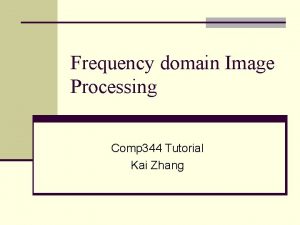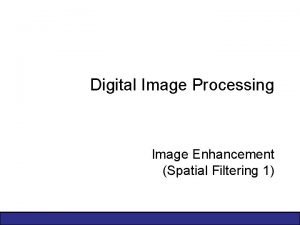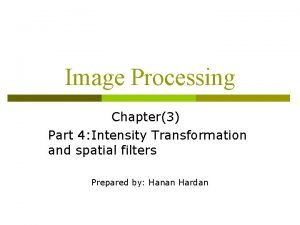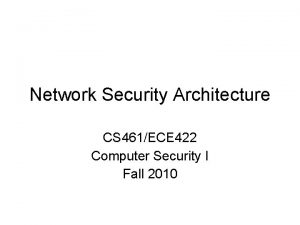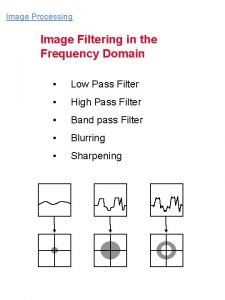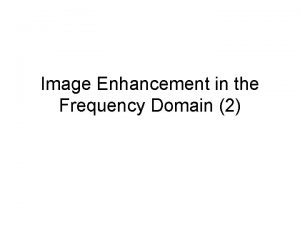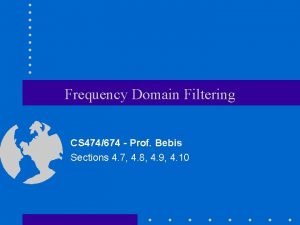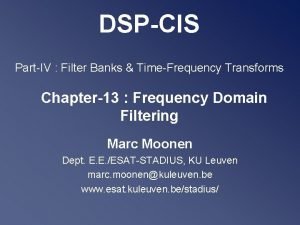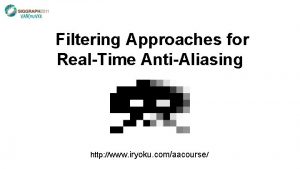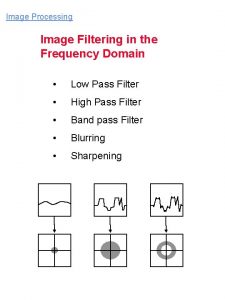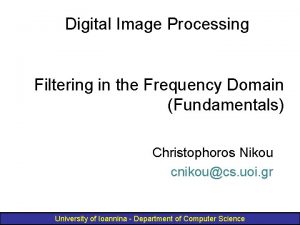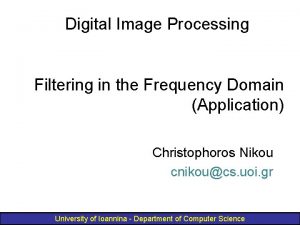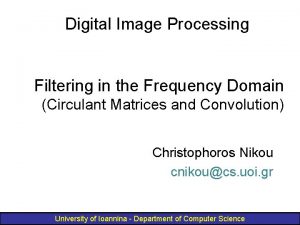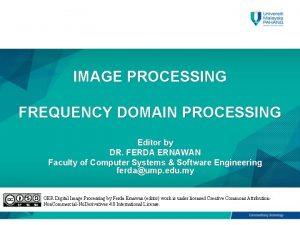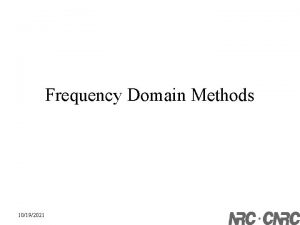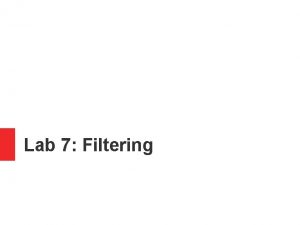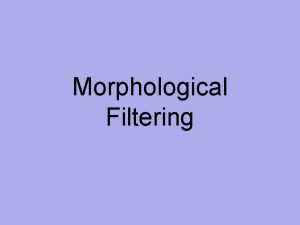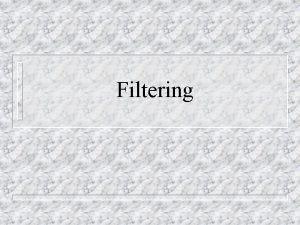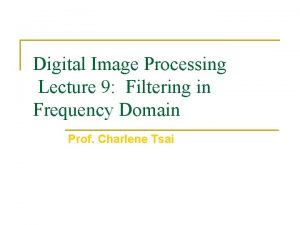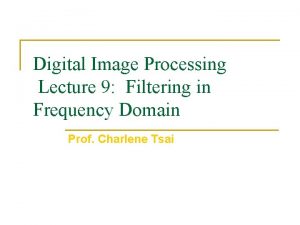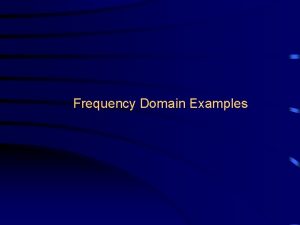Image Processing Ch 4 Filtering in frequency domain






































- Slides: 38

Image Processing Ch 4: Filtering in frequency domain Prepared by: Tahani Khatib AOU 1

Part 2 Filtering in frequency domain 2

Frequency Domain Filtering & Spatial Domain Filtering Similar jobs can be done in the spatial and frequency domains Filtering in the spatial domain can be easier to understand Filtering in the frequency domain can be much faster – especially for large images

Ch 4, lesson 8: The basics of filtering in the Frequency Domain (FD) introduction § § It consists of modifying the FT of an input image and then finding the IFT to get the output image. Mathematically its given by: G(u, v)= H(u, v)F(u, v) 4

Ch 4, lesson 8: The basics of filtering in the Frequency Domain (FD) Steps of frequency domain filter Multiply the input image by (-1)x+y 2. Compute F(u, v) 3. Multiply F(u, v) by a filter function H(u, v) 4. Compute the inverse DFT 5. Obtain the real part 6. Multiply the real part by (-1)x+y 5

Ch 4, lesson 8: The basics of filtering in the Frequency Domain (FD) Steps of frequency domain filter 1. 2. 3. 4. 5. 6. 7. 8. Given an input image f(x, y) of size Mx. N, select the padding parameters P=2 M and Q=2 N. Form a padded image of size Px. Q by appending the necessary zeros to f(x, y). Multiply padded image by (-1)(x+y) to center its transform. Compute the DFT F(u, v) of the image from step 3. Generate a real, symmetric filter function H(u, v) of size Px. Q. Form the product G(u, v)=H(u, v)F(u, v). Find the processed image by computing the real part of the IDFT of G(u, v) Multiply above by by (-1)(x+y) get g(x, y) from above step by extracting an Mx. N region from top left quadrant. 6

Ch 4, lesson 9: correspondence between FD & SD filters Correspondence between FD and SD filtering: § § SD: filtering is given by discrete convolution Correlation is… § FD: Discrete convolution in FD is equivalent to multiplication § Filtering can be done in either domain. 7

SD VS FD filters Low pass High pass Average filters laplace filters 8

Ch 4, lesson 10: low pass & high pass filters in FD Low pass & High pass filters in FD p Low-pass filter: A filter that attenuates high frequencies while passing low frequencies. - used for blurring (smoothing) p High-pass filter: A filter that attenuates low frequencies while passing high frequencies. used for sharpening 9

Ch 4, lesson 10: low pass & high pass filters in FD Low pass & High pass filters in FD 1) Low pass - Smoothing filters 1. 1) Ideal lowpass filters (very sharp) 1. 2) Butterworth lowpass filters 1. 3) Gaussian lowpass filters (very smooth) p p p Butterworth filter parameter: filter order High values: filter has the form of the ideal filter. Low values: filter has the form of the Gaussian filter. 2) High pass- Sharpening filters 2. 1) Ideal highpass filters 2. 2) Butterworth highpass filters 2. 3) Gaussian highpass filters 10

Ch 4, lesson 10: low pass & high pass filters in FD 1) Low pass – image smoothing Image smoothing using FD filters § Noise is usually high frequency. § Hence noise removal is usually termed smoothing or blurring. § Smoothing is achieved by lowpass filters (LPFs). § 3 types of LPFs will be studied i. e. Ideal LPF, Butterworth LPF and Gaussian LPF. § Note/Caution: Image details and edges have high frequency characteristics. 11

Ch 4, lesson 10: low pass filters 1) Low pass - image Smoothing filters: 1. 1) Ideal low pass filters (ILPF) 1. 2) Butterworth low pass filters (BLPF) 1. 3) Gaussian low pass filters (GLPF)

Ch 4, lesson 11: ILPF 2 -D Ideal low pass filter (1. 1 ILPF The simplest lowpass filter is ILPF, it (cuts off) all high frequency components that are at distance greater than a specified distance: D 0 from the center Where p D(u, v) is the distance from (u, v) to the center of the frequency rectangle p Image size: Mx. N p Center of the frequency rectangle: (u, v) = (M/2, N/2) p Distance to the center: D(u, v) = [(u – M/2)2 + (v – N/2)2]1/2 13



Ch 4, lesson 11: ILPF Ideal Low Pass Filter results Original image Ringing is a characteristics of ideal Filter Result of filtering with ideal low pass filter of radius 15 Result of filtering with ideal low pass filter of radius 80 Result of filtering with ideal low pass filter of radius 5 Result of filtering with ideal low pass filter of radius 30 Result of filtering with ideal low pass filter of radius 230 16 Ideal lowpass filtering is not very practical but they can be implemented on a computer to study their behavior.

Ch 4, lesson 11: ILPF Blurring and ringing feature of ILPFs: The ILPF has sharp cutoffs or discontinuities which cause ringing. § The ILPF has a sink function behaviour in the SD. § The center of lobe is the cause for blurring but the outer smaller lobes cause ringing. § We want to achieve blurring with little ringing. 17

Ch 4, lesson 12: BLPF 1. 2) Butterworth low pass filter BLPF: §ILPF transfer function has sharp discontinuities. §BLPF transfer function does not have sharp discontinuities in order to reduce ringing. The transfer function of a Butterworth lowpass filter of order n with cutoff frequency at distance D 0 from the origin is defined as: 18

Ch 4, lesson 12: BLPF Butterworth low pass filter : BLPF Note: ØH(U, V) =0. 50 (50% from its maximum value of 1) when D(u, v) =D 0 19

Ch 4, lesson 12: BLPF Butterworth Lowpass Filter (cont…) Original image Ringing is not visible in any of these images. Result of filtering with Butterworth filter of order 2 and cutoff radius 15 Result of filtering with Butterworth filter of order 2 and cutoff radius 80 Result of filtering with Butterworth filter of order 2 and cutoff radius 5 Result of filtering with Butterworth filter of order 2 and cutoff radius 30 Result of filtering with Butterworth filter of order 2 and cutoff radius 230

Ch 4, lesson 12: BLPF Ringing increases with filter order (n) as seen in SD

Ch 4, lesson 13: GLPF 1. 3) Gaussian Lowpass Filters -GLPF The transfer function of a Gaussian lowpass filter is defined as Note: The IFT (INVERSE FOURIOUR) of Gaussian is also Gaussian. Hence there is no ringing effect.

Ch 4, lesson 12: BLPF Gaussian low pass filter - GLPF: Note: ØH(U, V) =0. 667 when D(u, v) =D 0 23

Ch 4, lesson 13: GLPF Gaussian Lowpass Filters (cont…) No ringing Original image Result of filtering with Gaussian filter with cutoff radius 5 Result of filtering with Gaussian filter with cutoff radius 15 Result of filtering with Gaussian filter with cutoff radius 30 Result of filtering with Gaussian filter with cutoff radius 230

Lowpass Filters Compared Result of filtering with ideal low pass filter of radius 15 Result of filtering with Gaussian filter with cutoff radius 15 Result of filtering with Butterworth filter of order 2 and cutoff radius 15

Lowpass Filtering Examples A low pass Gaussian filter is used to connect broken text Machine recognition systems have difficulty in reading broken characters. GLPF with D 0 = 80

Lowpass Filtering Examples (cont…) Different lowpass Gaussian filters used to remove blemishes in a photograph

Ch 4, lesson 14: high pass 2)High pass - image Sharpening Blurring (smoothing) is achieved by attenuating ﺍﻟﺘﺨﻠﺺ the HF(high frequency) components of DFT of an image. (low pass filters) p Sharpening is achieved by attenuating the LF (low frequency) components of DFT of an image. Where Edges and fine detail in images are associated with high frequency components (high pass filters) p High pass filters – only pass the high frequencies, drop the low ones. High pass frequencies are precisely the reverse of low pass filters, so: Hhp(u, v) = 1 – Hlp(u, v)

Ch 4, lesson 14: high pass 2)High pass - image Sharpening filters: 2. 1) Ideal high pass filters (IHPF) 2. 2) Butterworth high pass filters (BHPF) 2. 3) Gaussian high pass filters (GHPF)

Ch 4, lesson 15: IHPF 2. 1) Ideal High Pass Filters The ideal high pass filter is given as: where D 0 is the cut off distance as before

Ch 4, lesson 15: IHPF Ideal High Pass Filters (cont…) Results of ideal high pass filtering with D 0 = 15 Results of ideal high pass filtering with D 0 = 30 Results of ideal high pass filtering with D 0 = 80

Ch 4, lesson 16: BHPF Butterworth High Pass Filters The Butterworth high pass filter is given as: where n is the order and D 0 is the cut off distance as before

Ch 4, lesson 16: BHPF Butterworth High Pass Filters (cont…) Results of Butterworth high pass filtering of order 2 with D 0 = 15 Results of Butterworth high pass filtering of order 2 with D 0 = 80 Results of Butterworth high pass filtering of order 2 with D 0 = 30

Ch 4, lesson 17: GHPF Gaussian High Pass Filters The Gaussian high pass filter is given as: where D 0 is the cut off distance as before

Ch 4, lesson 17: GHPF Gaussian High Pass Filters (cont…) Results of Gaussian high pass filtering with D 0 = 80 Results of Gaussian high pass filtering with D 0 = 15 Results of Gaussian high pass filtering with D 0 = 30

Highpass Filter Comparison BF represents a transition between the sharpness of the IF and the smoothness of the GF GF ﻭ IF ﻣﺮﺣﻠﺔ ﻭﺳﻄﻴﺔ ﺑﻴﻦ BF ﻳﻌﻨﻲ ﻳﻌﺘﺒﺮ GF ﺣﺎﺩ ﻟﻠﻐﺎﻳﺔ ﺑﻴﻨﻤﺎ ﻳﻤﺘﺎﺯ IF ﺣﻴﺚ ﻳﻌﺘﺒﺮ ﺑﻨﻌﻮﻣﺘﻪ

Highpass Filter Comparison Results of ideal high pass filtering with D 0 = 15 Results of Butterworth high pass filtering of order 2 with D 0 = 15 Results of Gaussian high pass filtering with D 0 = 15

The 3 HPF SD representation
 Nnnnnf
Nnnnnf Digital image processing
Digital image processing Intensity transformation and spatial filtering
Intensity transformation and spatial filtering Linear filtering citra
Linear filtering citra Ingress filtering vs egress filtering
Ingress filtering vs egress filtering Z domain to frequency domain
Z domain to frequency domain Data domain fundamentals
Data domain fundamentals Z domain to frequency domain
Z domain to frequency domain Z domain
Z domain Band pass filter in image processing
Band pass filter in image processing Frequency domain image
Frequency domain image Frequency filtering
Frequency filtering Frequency filtering
Frequency filtering Frequency filtering
Frequency filtering Point processing and neighbourhood processing
Point processing and neighbourhood processing Image enhancement point processing techniques
Image enhancement point processing techniques Histogram processing in digital image processing
Histogram processing in digital image processing Nonlinear image processing
Nonlinear image processing Point processing
Point processing Morphological processing in digital image processing
Morphological processing in digital image processing Image transform in digital image processing
Image transform in digital image processing Linear position invariant degradation
Linear position invariant degradation Compression models in digital image processing
Compression models in digital image processing Key stages in digital image processing
Key stages in digital image processing Fidelity criteria in image compression
Fidelity criteria in image compression Image sharpening in digital image processing
Image sharpening in digital image processing Image geometry in digital image processing
Image geometry in digital image processing Digital image processing diagram
Digital image processing diagram Digital image processing
Digital image processing Image geometry in digital image processing
Image geometry in digital image processing Image restoration in digital image processing
Image restoration in digital image processing Image filtering
Image filtering Conditional relative frequency example
Conditional relative frequency example Probability with relative frequency
Probability with relative frequency Form factor formula
Form factor formula Vmax=aw
Vmax=aw Frequency vs relative frequency
Frequency vs relative frequency What is a marginal frequency
What is a marginal frequency Marginal frequency distribution
Marginal frequency distribution
